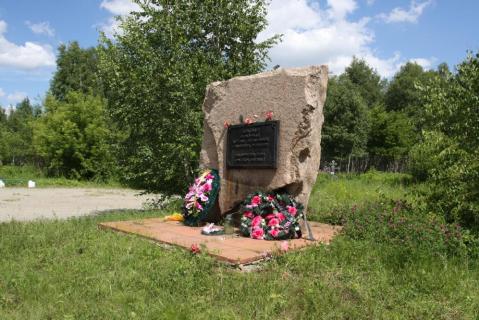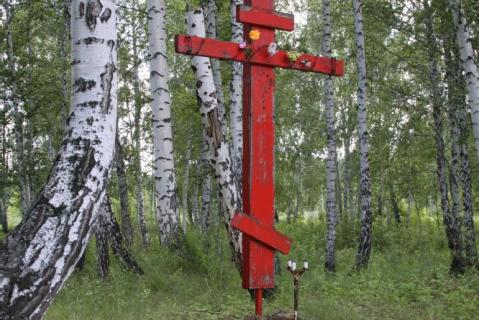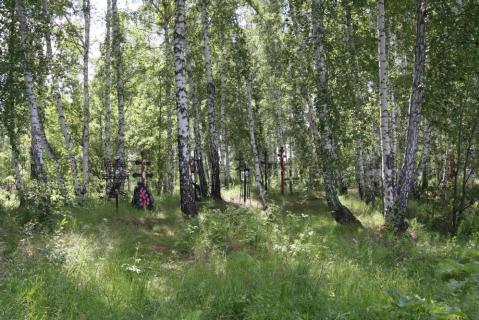The Zolotaya gora (Golden Hill) memorial cemetery is located on the western outskirts of Chelyabinsk between the settlements of Gradsky Mine (Priisk) and Shershnya. Here, on the territory of the former gold mine, executions took place in the 1930s and 1940s and the bodies of those shot were thrown into the worked-outs shafts. Some reports say that those shot in the city’s prisons were also buried here. The exact numbers are not known: archival sources indicate that 1,152 inhabitants of the Chelyabinsk Region were sentenced to death in the 1930s. After the war villagers from Shershnya grazed their cattle on land next to the Golden Hill; later they dumped rubbish there.
In spring 1989 the Chelyabinsk Memorial Society, supported by the local media, gathered witness statements and carried out investigations in the field: 10 mine shafts containing human bones were found. On 6 May that year the Chelyabinsk city executive committee adopted a resolution to create a memorial complex on the area where “the victims of Stalinist repression in the 1930s and 1940s were buried” and gave permission for excavation work. In 1989 and 1990, in the presence of officials from the prosecutor’s office and the KGB, mine shafts were excavated, and human remains were exhumed. The remains of 1,700 bodies were raised from two shafts. Forensic examination concluded that they had died between 1936 and 1939, before and after the Great Terror.
The reburial of remains first took place on 9 September 1989 when the memorial area was officially opened. In 1990 a second reburial of remains took place and in 1992 a third. A foundation stone was laid in the memorial area bearing the inscription, “Here will be a memorial area to the victims of unlawful Stalinist repression. Bow before this common grave!” In 1991 crosses with the words “Here lie the victims of Stalinist repression” were erected on each of the ten shafts where drilling tests showed there were human remains. (By 2008 only one of the crosses was still standing.) In 2001 a 14-metre-high memorial chapel (architect M.M. Semeikin) was built on the site. Personal memorials and cenotaphs have been placed in the area by relatives of those executed.
An incomplete Book of Remembrance for the Chelyabinsk Region was published online providing biographical entries for 23,000 individuals. It covers those shot or sent to the camps.
The Memorial online database (2025) includes 32,342 victims in the Chelyabinsk Region (BR 22,836).
More than half were local residents (18,625). 6,330 were shot, most during the Great Terror (5,944); 249 are listed as shot in the 1940s. Cases against 1,534 individuals were closed, 143 of whom died in custody. Almost 12,000 were sent to the camps; 900 were deported from the Region.
Police records add and name 9,429 German women and men transferred from elsewhere to special settlements in the Chelyabinsk Region, presumably in the 1940s. Earlier, more than 20,000 were sent from Tatarstan to special settlements in the Region; over five thousand were born there in such families.
| Date | Nature of ceremonies | Organiser or responsible person | Participants | Frequency |
|---|---|---|---|---|
|
February
|
Services for the Dead (parents Saturday)
|
nk
|
nk
|
Annual event
|
|
21 May
|
Day in Remembrance of Andrei Sakharov
|
Chelyabinsk Memorial Society
|
Memorial activists
|
Annual event
|
|
9-13 September
|
Regional Day in Remembrance of Victims of Political Repression
|
Chelyabinsk City administration
|
City and Regional officials, City organisation for defence of the rights of rehabilitated victims, Miass Memorial Society, relatives of victims
|
Annual Event
|
| State of burials | Area | Boundaries |
|---|---|---|
|
burials have survived
|
more than 73,000 sq m
|
not delineated
|
[ original texts and hyperlinks ]
V. Borisov, “The pain we share”, Nauka Urala, 27 July 1989
G. Izhbuldin, “To name all the names”, Ogonyok, 1989, No. 7
S. Mironova, “Whatever happens to me, believe …”, Chelyabinsk rabochy, 9 September 1989
A. Novoselov, “Revelation on the Golden Hill”, Uralsky sledopyt, 1989, No. 11
Archival materials of the the Centre for Historical and Cultural Heritage (Chelyabinsk)
*
Reply from the Chelyabinsk City culture department (No. 484 of 18 April 2014) to a formal enquiry by RIC Memorial (St Petersburg)




